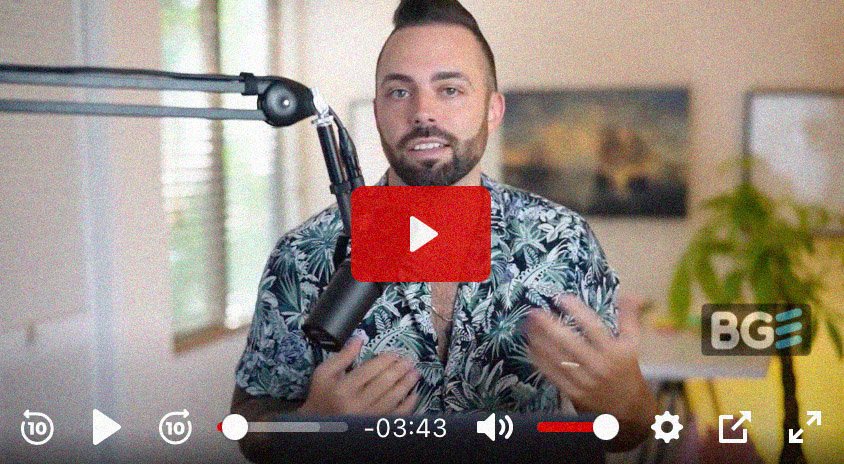From BGE to “Launch to $10K”, Enfroy’s strategic shift signals the end of SEO-first blogging
This article started as a review of Adam Enfroy’s Blog Growth Engine (BGE). It reflected my scepticism about influencer courses that still followed a pre-AI web strategy: long-form, keyword-targeted posts and aggressive link building to raise authority.
Fast forward a few months: BGE has effectively been retired and rebranded as AI Income Blueprint. The BGE domain now functions as an 80-minute free masterclass lead magnet. AI Income Blueprint likewise leads with a free masterclass opt-in, with an enrol page deeper in the site. Meanwhile, Enfroy’s homepage pushes a Free Income Launch Plan that funnels to Launch to $10K.
Launch to $10K reuses BGE’s language and testimonials, but leaves behind the blog-first, affiliate model. Instead, it steers beginners towards selling packaged content services to local businesses.
This format looks short lived. “A calm, quiet path to $10k per month”, as is advertised, is a strong promise in a crowded, fast-moving market. Once the same prompts and templates flood the market, prices will slide and the path to $10k will fade.

BlogGrowthEngine.com homepage (accessed August 2025). Detail showing the presentation video.
Enfroy’s take on the 2025 blogging landscape
In recent content, Enfroy acknowledged the impact of Google’s March 2024 core and spam updates, and the wider shift in search behaviour with AI Overviews. He suggested:
- Narrowing your niche to avoid giant competitors.
- Paying for backlinks as guest posting gets harder and more commercialised.
- Diversifying traffic beyond SEO into email, social ads, and multiple platforms (Adam now explicitly advises incorporating social media ads alongside organic traffic and email marketing to reduce reliance on Google).
- Accepting it could take several years to monetise without major investment
In other words, running a commercial website today is indistinguishable from running any other business: you need real distribution, partnerships, budget, compliance, and profit discipline, not just posts and links.
Is link-building still an effective path to generate traffic?
Adam’s preferred route for faster results involved structured outreach, partnerships, and sometimes significant paid link investment. But link-building as an SEO lever is now weaker, riskier, and more expensive than it used to be:
- Google has explicitly de-emphasised links in documentation and guidance, and spam/paid patterns are more likely to be ignored or penalised.
- AI Overviews and rising zero-click behavior mean fewer users click through from informational queries, so the ROI of ranking-by-links alone is lower.
- Compliance risk is high if money, link swaps, or scaled schemes are involved. Google’s 2024–2025 spam updates target manipulative patterns more aggressively.
AI estimates: the probability of success for a new/low-authority blog in 12 months purely via link-driven SEO is ~10–20% if you have real PR stories and a proactive, strategic role. But only single digits if it’s mostly paid links or swaps. If executed as genuine PR that earns coverage and sends referrals, traffic success rises to ~25–40% because you’re not relying on Google alone.
And content-building?
Content-building alone is slower and, in a world of AI Overviews and zero-click search, delivers less Google traffic per ranking than before. As with link-building, it can still work but only when it creates real demand and referral traffic beyond Google.
Ranking power still matters, but each ranking is worth less traffic on many queries. Without distribution or an existing audience, it now takes even longer to get any traffic.
AI estimates: probability of success for a new blog via content alone aimed at Google in 12 months, is about ~5–15% to reach meaningful organic traffic. If you pair content with distribution (social, newsletters, communities) and treat Google as just one input, success odds can improve to ~25–40%.
Final thoughts
Influencer courses do not confer a special edge. Evaluate them like any other marketing product: buy only if a specific module helps you execute your plan faster or better, and ignore the rest.
🎧
Prefer to listen? This topic is also explored in one of my podcast episodes:
Sources:
- GrowthEngine.blog: Blog Growth Engine Review 2025
Breakdown of the 13-phase curriculum, including updates like AI modules and bonuses. - Blog Growth Engine (Official Site): Testimonials Page
Collection of student success stories, including case studies of bloggers scaling from zero to $10K+ months. - Community feedback (Reddit, etc.)
Great to have you here! Feel free to leave your thoughts in the comments.
Hello, I’m John Dawson, a graphic designer (for a little while longer) and the writer behind DawsonDecoded, where I share hands-on insights on AI, blogging, social media, and whatever else crosses my mind.”
Get new posts by email when they’re worth sharing.
No spam.
More course reviews:
How to fact-check your blog post
Reading Time: 5 minutesFact-checking protects both you and your readers. This simple process allows you to separate facts from opinions, verify claims, and add safeguards so your published content remains accurate, credible, and trustworthy.
Are influencer courses still worth it in 2025, or just built on yesterday’s internet?
Reading Time: 3 minutesOnline courses promise to teach you how to make money as a creator. But in 2025, are they worth it or just selling outdated methods?
More course reviews:
You might like:
Words that are mine
Reading Time: 2 minutesAfter months of writing mostly for algorithms and sales funnels, I stopped obsessing over online income and started writing in my own voice.
Eight months chasing a mirage
Reading Time: 3 minutesEight months in, I’m changing course. I’m going back to casual blogging and stepping away from the commercial / affiliate angle. The pressure’s off, and I finally have my life back.
How to start a blog and find your first readers (part 3)
Reading Time: 9 minutesMake it look and feel professional: pick a lightweight theme, set a basic brand kit, and publish the must‑have pages.
How to fact-check your blog post
Reading Time: 5 minutesFact-checking protects both you and your readers. This simple process allows you to separate facts from opinions, verify claims, and add safeguards so your published content remains accurate, credible, and trustworthy.
Can you still make a living from a blog in 2025?
Reading Time: 5 minutesBetween viral promises and reality, can a blog still generate a viable income in 2025? Here’s what the numbers say.
Blogging with AI
Reading Time: 4 minutesAI can speed up ideas, drafts, and edits, but it should assist rather than replace you. Keep your voice, verify facts, and add your perspective so posts stay authentic and useful.
How to start a blog and find your first readers (part 2)
Reading Time: 8 minutesIn Part 2 of this beginner’s guide, we move from idea to reality by getting your blog online. You’ll learn what domains and hosting actually are, and how to install WordPress in just a few clicks.
How to start a blog and find your first readers (part 1)
Reading Time: 6 minutesLearn how to choose a blog niche you’ll love and a name that can grow with you, the first step in building a successful blog.
The dark side of online income: how scammers are using AI and social media to make millions
Reading Time: 7 minutesScammers use AI and social media ads to create fake funnels that mimic legitimate ones. This post explains how they work and what ethical marketers can learn.
Betting on yourself: why creating content will always be more profitable than playing the lottery
Reading Time: 8 minutesWhy blog instead of buying lottery tickets? Because the odds and the long-term payoff make content creation a far smarter bet for financial success.













Leave a Reply